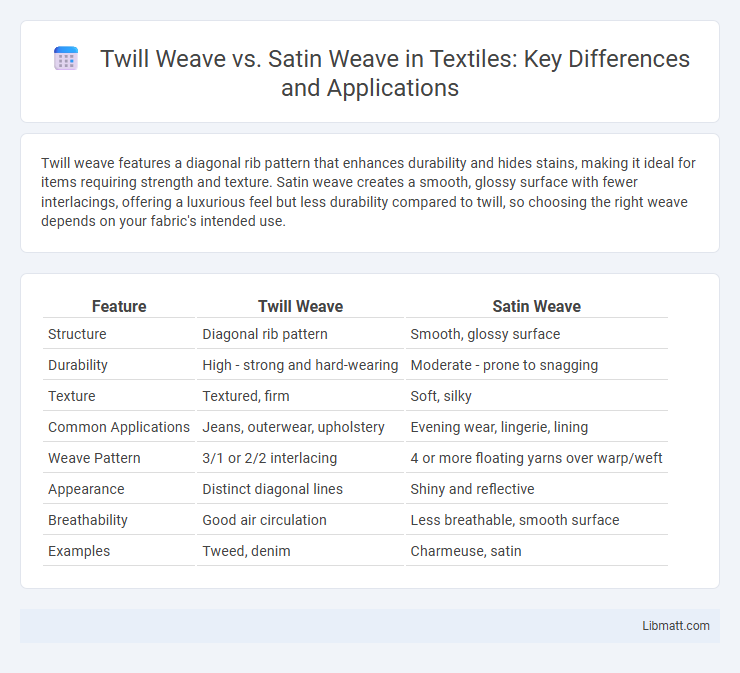Twill weave features a diagonal rib pattern that enhances durability and hides stains, making it ideal for items requiring strength and texture. Satin weave creates a smooth, glossy surface with fewer interlacings, offering a luxurious feel but less durability compared to twill, so choosing the right weave depends on your fabric's intended use.
Table of Comparison
| Feature | Twill Weave | Satin Weave |
|---|---|---|
| Structure | Diagonal rib pattern | Smooth, glossy surface |
| Durability | High - strong and hard-wearing | Moderate - prone to snagging |
| Texture | Textured, firm | Soft, silky |
| Common Applications | Jeans, outerwear, upholstery | Evening wear, lingerie, lining |
| Weave Pattern | 3/1 or 2/2 interlacing | 4 or more floating yarns over warp/weft |
| Appearance | Distinct diagonal lines | Shiny and reflective |
| Breathability | Good air circulation | Less breathable, smooth surface |
| Examples | Tweed, denim | Charmeuse, satin |
Introduction to Textile Weaves
Twill weave features a distinctive diagonal rib pattern created by interlacing warp and weft threads in a simple, repeated sequence, resulting in strong, durable fabrics commonly used in denim and upholstery. Satin weave, characterized by long floats of yarn over several threads before interlacing, produces a smooth, glossy surface with enhanced luster and softness, preferred in luxury garments and bedding. The structural differences between twill and satin weaves directly influence fabric texture, durability, and aesthetic appeal, making each suitable for specific textile applications.
What is Twill Weave?
Twill weave is characterized by a distinctive diagonal rib pattern created by the weft thread passing over one or more warp threads and then under two or more warp threads in a repeating sequence. This weave structure gives twill fabrics enhanced durability, resistance to wrinkles, and better drape compared to plain weaves. Your choice of twill weave ensures a balanced combination of strength and aesthetic appeal, commonly used in denim, chino, and workwear textiles.
What is Satin Weave?
Satin weave is a textile construction characterized by a smooth, lustrous surface created by floating warp yarns over multiple filling yarns, producing minimal interlacings. This weave results in a glossy front and a dull back, ideal for fabrics requiring a luxurious appearance and soft hand feel. Your choice of satin weave enhances fabric drape and sheen, distinguishing it from the diagonal texture of twill weave.
Structural Differences: Twill vs Satin
Twill weave features a distinct diagonal rib pattern created by interlacing warp and weft threads in a 2-over, 1-under sequence, resulting in a durable and textured fabric. Satin weave interlaces threads in a floating pattern where warp yarns pass over multiple weft yarns before going under one, producing a smooth, glossy surface with minimal visible weave structure. The structural difference lies in twill's pronounced diagonal lines and satin's characteristic sheen from long floats, impacting fabric strength and appearance.
Visual and Textural Characteristics
Twill weave features a distinctive diagonal rib pattern that creates a textured surface with a sturdy feel, often resulting in a matte finish. Satin weave, in contrast, has fewer interlacings, producing a smooth, lustrous surface with a soft drape that reflects light beautifully. Your choice between these weaves influences both the fabric's tactile experience and its visual appeal, ranging from durable and structured to sleek and shiny.
Durability and Strength Comparison
Twill weave offers superior durability and strength due to its diagonal rib pattern, which distributes stress evenly across the fabric, making it less prone to tearing and abrasion. Satin weave, characterized by its smooth, glossy surface created by floating yarns, sacrifices some durability for aesthetic appeal and softness, often resulting in a fabric that is more delicate and susceptible to snagging. For your needs requiring long-lasting, robust material, twill weave presents a more practical choice compared to satin weave.
Common Uses of Twill and Satin Weaves
Twill weave is commonly used in durable fabrics like denim, chinos, and upholstery due to its diagonal rib pattern and strength, making it ideal for workwear and heavy-duty applications. Satin weave is favored for luxury items such as evening gowns, lingerie, and upholstery that require a glossy, smooth surface with enhanced luster and soft drape. Choosing between twill or satin weaves will depend on your need for durability versus elegance in textile applications.
Advantages and Disadvantages
Twill weave offers durability and resistance to wrinkles due to its diagonal rib pattern, making it ideal for heavy-duty fabrics like denim; however, it may appear less smooth and less lustrous compared to other weaves. Satin weave provides a smooth, glossy surface that enhances fabric sheen and drape, perfect for luxurious garments, but it tends to snag easily and is less durable under frequent wear. Your choice between twill and satin weaves depends on the balance you require between strength and aesthetic appeal.
Price and Production Considerations
Twill weave generally offers lower production costs due to its simpler interlacing pattern and faster weaving speed compared to satin weave, which requires more precise control and higher-quality yarns. Satin weave fabrics tend to be more expensive because of the intricate weaving process that produces a smooth, glossy surface, increasing labor and material expenses. Manufacturers often choose twill weave for cost-effective, durable textiles, while satin is reserved for premium products demanding luxury and aesthetic appeal.
Choosing the Right Weave for Your Needs
Twill weave offers durability and a distinct diagonal pattern, making it ideal for workwear and upholstery where strength and resistance to wear are essential. Satin weave provides a smooth, lustrous surface with a sleek appearance, perfect for luxury garments and bedding that emphasize softness and sheen. Selecting between twill and satin weaves depends on balancing the need for durability and texture against the desired aesthetic and tactile qualities.
Twill weave vs Satin weave Infographic

 libmatt.com
libmatt.com